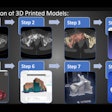
Scientists have published new evidence of concentrations of gadolinium detected in rivers in the Muenster area of western Germany. The contamination is linked with the release of gadolinium-based contrast agents (GBCAs) used in MRI.
There is an ongoing need for efficient GBCA monitoring in aquatic environments, noted senior author Prof. Dr. Uwe Karst and colleagues from the Department of Analytical Chemistry at the University of Muenster in an article published in the December edition of Water Research.
"Long-term ecotoxicological effects of GBCAs are mainly unknown and thus powerful methods of speciation analysis are required to monitor their distribution and fate in aquatic systems," they reported in the journal of the International Water Association, which publishes research on the science and technology of water quality and its management.
Sample analysis
Karst's team has developed a powerful method for the automated speciation analysis of GBCAs. Using this technique, the group can achieve a rapid separation of five commonly administered GBCAs by means of anion-exchange chromatography. The chromatographic run time of the optimized method is below two minutes.
 Map of the Ems River sampling area that shows the individual sampling points and the location of wastewater treatment plants (WWTPs) as sources of anthropogenic gadolinium in surface waters. Samples E1-E5 were obtained in September 2019, and samples E4 and E5 were collected in December 2019. Figures courtesy of Marcel Macke et al. and Water Research.
Map of the Ems River sampling area that shows the individual sampling points and the location of wastewater treatment plants (WWTPs) as sources of anthropogenic gadolinium in surface waters. Samples E1-E5 were obtained in September 2019, and samples E4 and E5 were collected in December 2019. Figures courtesy of Marcel Macke et al. and Water Research.The researchers applied this method for high-throughput screening of several water samples, which were obtained from different river and creek systems in the vicinity of Muenster.
They found that complex Gd-DOTA appeared to be the most abundant species as it was identified in all analyzed samples, but other macrocyclic compounds like Gd-HP-DO3A and Gd-BT-DO3A were also detected. The researchers also found no determinable amounts of linear contrast agents, matching the current national regulations for GBCA administration.
"For one sampling area, the occurrence of an unassignable gadolinium peak could be observed," they stated. "Potential sources of this unknown species were discussed, but the detailed structure could not be elucidated thus far."
 Comparison of the quantification results for the samples E1-E5 and proportion of the individual GBCA concentrations to the total gadolinium content. Total GBCA concentration was calculated by summing the individual GBCA concentrations. Error bars represented 2SD of triplicate analysis.
Comparison of the quantification results for the samples E1-E5 and proportion of the individual GBCA concentrations to the total gadolinium content. Total GBCA concentration was calculated by summing the individual GBCA concentrations. Error bars represented 2SD of triplicate analysis.The organic solvent-free chromatography, the simplified preparation workflow, and the automation approach turned out to be beneficial for accelerated GBCA monitoring, the authors wrote.
Radbruch responds
Prof. Dr. Alexander Radbruch, JD, chair of diagnostic and interventional neuroradiology and professor at Rheinische Friedrich Wilhelms University Bonn, Germany, is convinced this is a valuable piece of research.
"Environmental gadolinium is definitely an issue we will hear more about in the coming years," he told AuntMinnieEurope.com.
"The amount that is in the sewage water is still extremely small," Radbruch added. "However, we should monitor this development carefully, and new tools that facilitate the detection of gadolinium would be a great help. I am sure that the radiological community will welcome the new detection and quantification method."



















